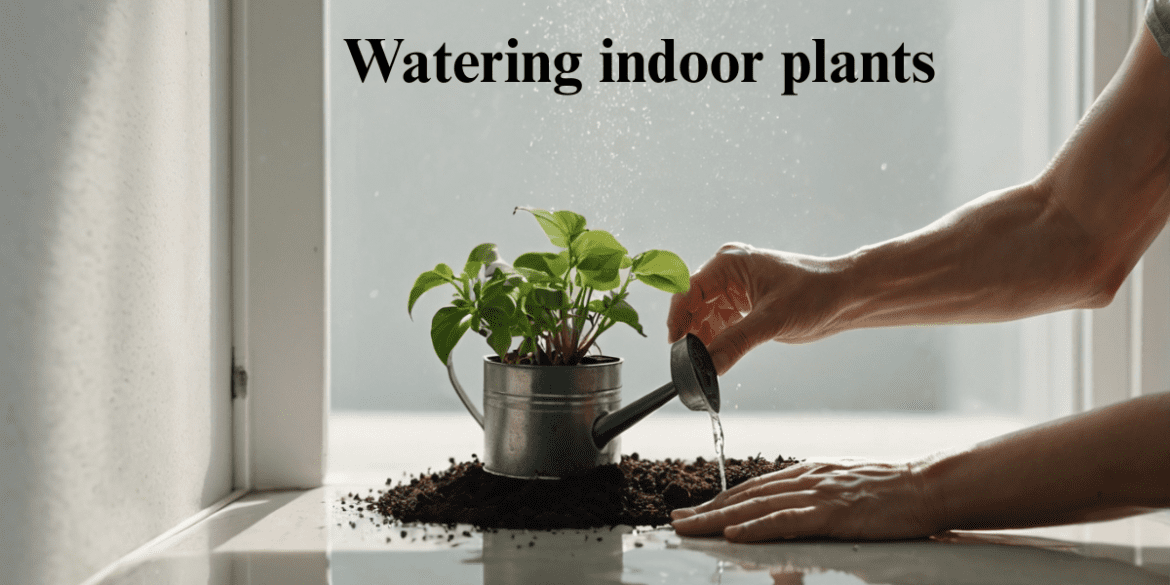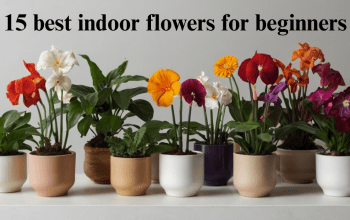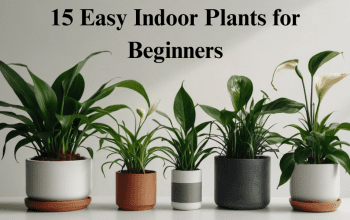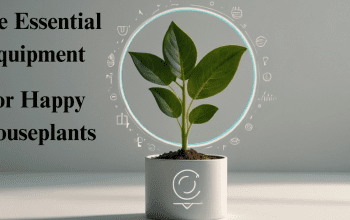Let’s be honest: watering indoor plants sounds like the easiest job in the world. Just pour some water, right? But if you’ve ever owned a plant, you know it’s not that simple. One day, your pothos looks like it could star in a skincare commercial—glowing, perky, flawless. The next day? It’s limp, yellowing, and silently screaming, “What did you do to me?!” Suddenly, you’re Googling things like, “Can plants get depression?” or “How much water is too much water?”
If this sounds familiar, you’re not alone. Nearly every plant parent—whether beginner or seasoned—has struggled with the eternal question: “Am I watering my plants too much or too little?” The truth is, water can be your plants’ best friend or their worst nightmare. Too little, and they’re parched. Too much, and they’re practically drowning. Finding the balance is both an art and a science.
But here’s the good news: once you understand the basics, watering indoor plants doesn’t have to feel like rocket science. In fact, it can become second nature—something you actually enjoy doing (yes, really). Think of it less like a chore and more like a conversation with your plants. They have ways of telling you what they need—you just need to know how to listen.
In this guide, we’ll dive deep (but not too deep, promise) into everything you need to know about watering your indoor plants the right way. From understanding soil moisture to spotting signs of overwatering, we’ll break it all down in simple, practical steps—so your plants can thrive and you can finally stop guessing.
How to Water Indoor Plants
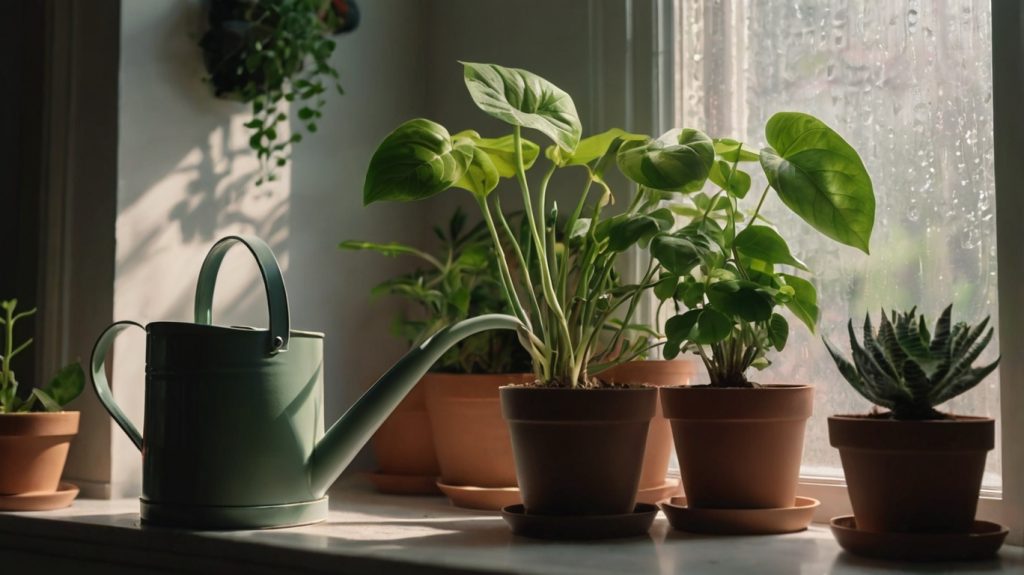
Okay, so how do you water indoor plants without accidentally turning your living room into a swamp or a desert? First things first: watering is not just about dumping water until it overflows like a soda machine at a gas station. It’s about technique, timing, and a little bit of observation.
Start by checking the soil. Stick your finger in about an inch deep (yes, get your hands dirty—plants love that). If it feels dry at that level, it’s time for a drink. If it’s still moist, resist the urge! Your plant isn’t thirsty yet, no matter how much you want to “do something.” Overwatering is basically plant parent smothering.
When you do water, go for a deep soak rather than a sprinkle. Imagine you’re filling up the soil’s “reservoir” instead of just wetting the surface. Pour slowly and evenly until water starts draining out the bottom of the pot. (And yes, drainage holes are non-negotiable. Without them, you’re just creating a soggy mud pie.)
Another tip: use room-temperature water. Plants don’t like icy showers any more than you do at 6 a.m. A sudden blast of cold water can shock their roots.
Lastly, consistency matters. Try to water at roughly the same time of day. Morning is best because it gives plants time to absorb water before the sun (or grow lights) get too intense. Think of it like giving them breakfast instead of a midnight snack.
Watering isn’t just a task—it’s a ritual. Once you get the hang of it, it feels less like maintenance and more like nurturing.
What to Consider Before Watering Houseplants
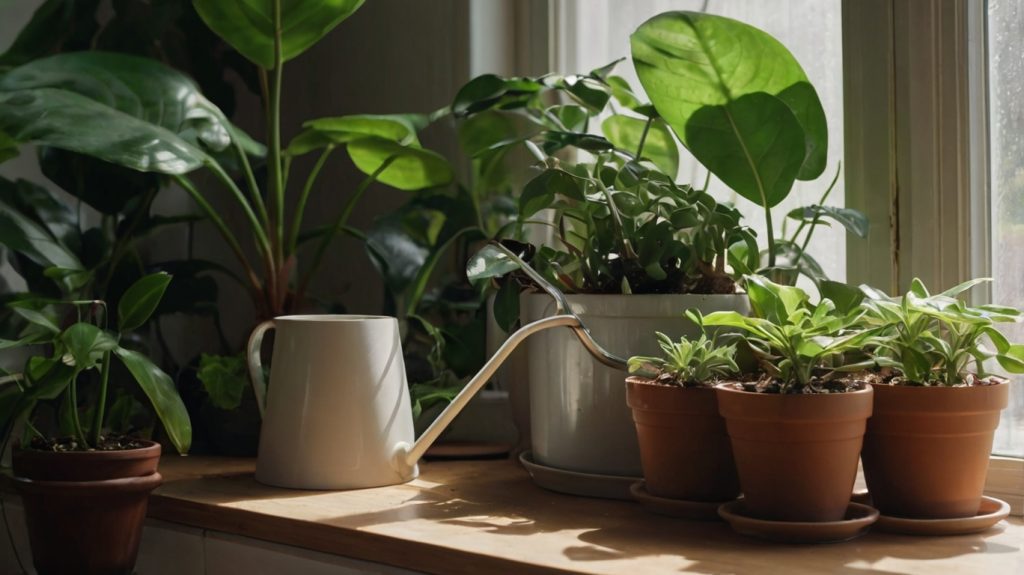
Here’s the funny thing about watering: it’s less about the act and more about the context. Before you grab that watering can, you need to play detective. Why? Because plants aren’t all created equal, and what works for a cactus won’t work for a fern.
First, consider the type of plant. Succulents and cacti? They like a desert-style drought before their next drink. Tropical plants like ferns or peace lilies? They’re drama queens that crave consistent moisture. Knowing your plant’s personality is half the battle.
Next, check the environment. Is your plant sitting by a sunny window where it bakes all afternoon? Or is it tucked in a shady corner that feels like a cave? Light affects how quickly soil dries out. More light usually means more frequent watering, less light means slower drying time.
Also, think about the pot and soil. Clay pots dry out faster than plastic ones, and a loose, airy soil mix will drain quicker than compact, heavy soil. Translation: two identical plants in different pots may need completely different watering schedules.
Humidity is another sneaky factor. If you live in a dry climate (or run the heater all winter), your plants will drink up faster. In a humid environment, they might go longer without a sip.
Finally, always ask yourself: Is the soil really dry? Don’t water just because “it’s Tuesday.” That’s how you drown plants. Instead, check moisture levels first—your finger, a wooden chopstick, or even a fancy moisture meter will do the trick.
The bottom line? Watering isn’t about a fixed schedule; it’s about observation. Once you start considering these factors, you’ll stop guessing and start watering like a pro—making both you and your leafy friends much happier.
Check the Soil Before Watering
Here’s the golden rule of indoor gardening: don’t water until your soil says so. Think of it like this—watering a plant without checking the soil is like feeding someone who just finished Thanksgiving dinner. Spoiler alert: they’re not hungry, and they’re going to feel sick.
So how do you know when your soil is truly thirsty? The simplest way: the finger test. Stick your finger about an inch deep into the soil (yes, you’ll get a little dirt under your nails, but that’s the badge of honor for plant parents). If it feels dry at that depth, your plant is ready for a drink. If it’s still moist, hold off. Easy, right?
Another method is the chopstick or skewer trick. Push a wooden skewer into the soil. Pull it out—if it comes out clean and dry, time to water. If it’s damp with soil clinging, your plant’s good for now.
For those who like gadgets, moisture meters are your new best friend. They read the soil’s moisture level and give you numbers instead of guesswork. Great for beginners or anyone who doesn’t trust their “plant intuition” yet.
Remember, appearances can be deceiving. The top inch of soil may look bone dry, but deeper down it could still be moist. That’s why checking matters. Plants hate soggy roots more than toddlers hate naps.
Bottom line: let the soil tell you what to do. Your plants can’t text you “I’m thirsty,” but their soil? That’s basically their group chat.
Roles of Pot Size / Type of Pot
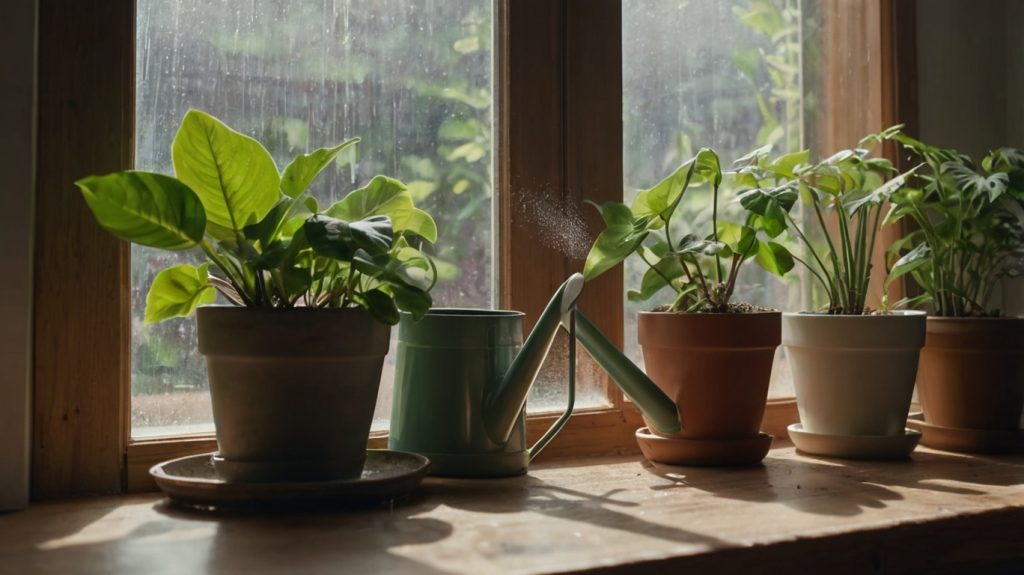
Now, let’s talk pots—because they’re more than just “something cute you saw at IKEA.” The pot your plant lives in can make or break your watering game.
First up, pot size. Imagine giving a tiny goldfish a swimming pool versus a small bowl. Too big a pot, and your plant’s roots will swim in excess soil that holds extra water, leading to soggy disasters. Too small, and the soil dries out faster than you can say “parched.” The key is balance—choose a pot just a little bigger than your plant’s root ball so it has room to grow but not drown.
Then there’s the type of pot. Clay or terracotta pots are breathable and wick moisture away faster. They’re perfect if you tend to overwater, but you’ll need to water more often. Plastic pots, on the other hand, hold onto moisture longer—great for busy (or forgetful) plant parents, but risky if you’re heavy-handed with the watering can. Ceramic pots? Stylish, but make sure they’ve got a drainage hole. No drainage = root rot city.
Speaking of drainage holes, let me be crystal clear: they are not optional. A pot without holes is basically a water prison. Excess water has nowhere to escape, and roots will suffocate. If you fall in love with a gorgeous pot that has no hole—no worries. Just use it as a decorative outer cover and keep your plant in a smaller, drainable pot inside.
So yeah, pots aren’t just fashion accessories for your plants. They play a starring role in how often and how successfully you water. The right pot is like giving your plant a home with good plumbing—it makes everything easier.
Role of Temperature
Here’s a fun fact: your plants are basically tiny, leafy weather stations. Temperature plays a massive role in how much water they need, and ignoring it is like wearing a winter coat in July—uncomfortable and completely unnecessary.
When it’s warm, plants act like marathon runners—they’re constantly using up energy and losing water through evaporation and transpiration (a fancy word for plant sweat). This means you’ll likely need to water more often in summer or if your home runs hot. A plant near a heater? Even thirstier.
Now, when it’s cold, plants slow way down. Think of it as their lazy Netflix-and-chill season. Their growth pauses, water needs decrease, and the soil stays moist longer. Keep watering them like it’s summer, and you’ll end up with soggy soil and sad, mushy roots.
Also, don’t forget about temperature swings. Drafty windows in winter or hot blasts from an AC vent in summer can stress your plants big time. Temperature stress doesn’t just confuse their growth—it also throws off how fast they drink up water.
Bottom line: always sync your watering with the season. Hot temps = more frequent watering. Cool temps = less. Your plant isn’t being dramatic—it’s just reacting to its environment. Treat temperature like your plant’s personal thermostat, and you’ll be golden.
Role of Humidity
If temperature is your plant’s thermostat, then humidity is its personal spa. Most indoor plants—especially tropical ones—love humidity. It keeps their leaves plump, shiny, and happy. But when the air gets too dry? They shrivel, crisp up, and look like they’ve aged 20 years overnight.
Humidity affects watering because when the air is dry (hello, winter with the heater blasting), water evaporates faster from both soil and leaves. This means you’ll often have to water more frequently to keep up. In contrast, in high-humidity environments (think bathrooms or kitchens), soil tends to stay moist longer, so watering needs decrease.
Signs your plant is crying out for more humidity? Brown, crispy leaf tips, drooping leaves, or buds that refuse to open. Basically, it looks like it needs a gallon of moisturizer.
So, how do you fix it? Easy hacks include grouping plants together (they create their own mini jungle atmosphere), using a humidity tray (fancy term for “a plate with pebbles and water”), or investing in a small humidifier. Bonus: your skin will thank you too.
Just remember, humidity isn’t a replacement for watering. It works alongside it. Think of watering as the main course and humidity as the delicious side dish—it makes everything better. Balance the two, and your plants will thrive instead of merely survive.
Role of the Water Quality
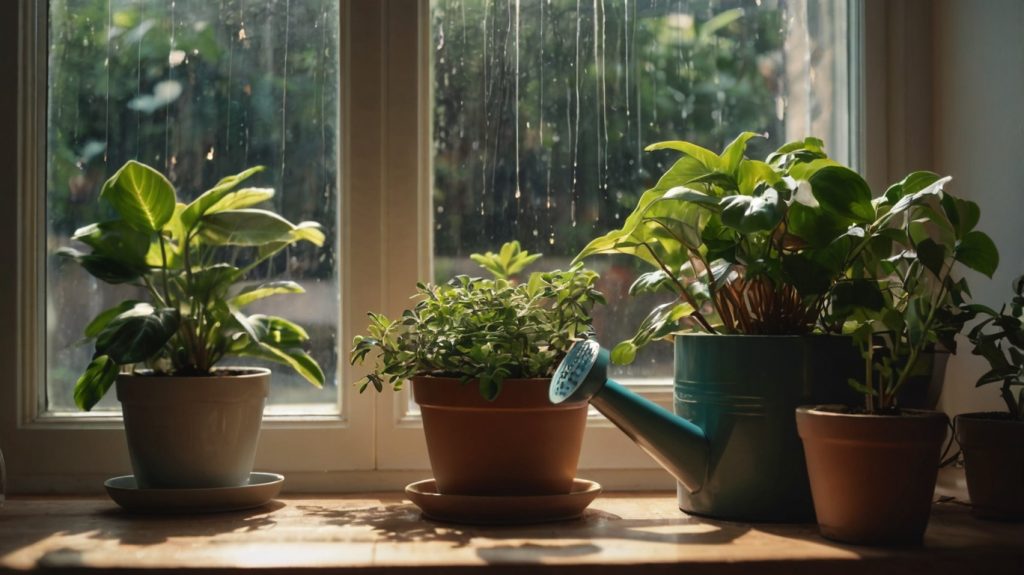
Here’s the thing: not all water is created equal. To us, water is water—we drink it, cook with it, maybe even splash some on our face when we’re half-asleep. But to plants? Water quality can mean the difference between thriving and, well, looking like they’ve had a rough night out.
Tap water is usually fine for many houseplants, but it often contains chlorine, fluoride, and salts that can build up in the soil over time. Some plants (like peace lilies, spider plants, or ferns) are super sensitive to these extras and may develop brown tips as a result. Basically, they’re the picky eaters of the plant world.
If you’ve noticed weird leaf spots or unexplained sulking from your plants, your tap water might be the culprit. Solutions? Let tap water sit out overnight so the chlorine can evaporate, or use filtered water if you’ve got a Brita handy.
Rainwater is like liquid gold for plants (free, natural, and full of minerals they actually like). Distilled water works too, but it’s a bit like feeding them bottled spring water every day—luxurious but not always practical.
So yes, water quality matters. Think of it like this: you wouldn’t want to hydrate with soda or saltwater, right? Neither do your plants. Give them the cleanest water you can, and they’ll reward you with greener leaves and fewer tantrums.
Time of Year
Here’s a secret: watering isn’t a “set it and forget it” kind of deal. It changes with the seasons, and if you don’t adjust, your plants will definitely let you know (usually by collapsing dramatically).
Spring and summer are growth seasons. Plants are stretching, sprouting new leaves, and basically going through their glow-up phase. They’ll drink more water during this time, so you’ll find yourself watering more frequently. Think of them like teenagers—they eat (or in this case, drink) nonstop.
Fall and winter, though? Totally different story. Growth slows down, light is weaker, and indoor heating dries the air. Your plants need less water because they’re not working as hard. Keep up your summer watering routine in winter, and congratulations—you’ve just bought yourself a ticket to Root Rot City.
But there’s nuance. Some plants (like tropical evergreens) keep growing indoors year-round, especially if they’re near grow lights. Others go semi-dormant and barely sip water. This is why paying attention to both the season and your plant’s actual behavior is crucial.
Here’s a tip: create a “seasonal shift” mindset. As days get longer and sunnier, water a little more. As days shorten and your plant slows down, pull back. Simple.
So yeah, time of year matters. Watering is seasonal, just like fashion—don’t let your plant wear a parka in July or shorts in December. Adjust, and you’ll both be happier.
6 Tips to Properly Water Your Plants
Watering plants isn’t rocket science… but it’s also not just “dump water whenever you remember.” To keep your green buddies thriving, you need a bit of strategy (and maybe a tiny splash of common sense). Here are six golden rules every plant parent should live by:
- Water Deeply, Not Lazily
Think of watering like making coffee—you wouldn’t just drizzle a teaspoon over the beans and hope for espresso. Same with plants. Always water thoroughly until it drains from the bottom. This ensures the roots (a.k.a. the plant’s stomach) actually get fed. - Timing Is Everything
Watering at night? Bad idea. The soil stays damp longer, which can lead to root rot. Mornings or early afternoons are best—plants drink up happily and have the whole day to dry off. - Use Room-Temperature Water
Cold tap water is basically a shock bath for roots. Hot water? Even worse. Stick to room temperature—your plants will thank you by not fainting. - Bottom Watering = Secret Weapon
Every so often, place your pot in a tray of water and let the soil soak it up from the bottom. It encourages deeper root growth and prevents surface-only watering. - Adjust with the Seasons
Summer = thirsty plants. Winter = chill, less thirsty plants. Adjust your watering schedule like you adjust your wardrobe. - Listen to Your Plant
Droopy leaves, yellowing, crispy tips—plants have more drama than reality TV. Pay attention. They’re literally telling you when you’re doing too much or not enough.
Follow these six tips, and you’ll go from “accidental plant killer” to “the neighborhood plant whisperer” in no time.
Final Thoughts: Becoming a Confident Plant Waterer
So, here we are—you started this guide wondering if watering plants was some mystical art only seasoned gardeners knew, and now? You’ve basically unlocked the cheat codes. You know how to check soil, why pot size matters, the role of temperature and humidity, and even how to avoid giving your plants the leafy equivalent of a hangover (overwatering) or a desert trek (underwatering).
At the heart of it, watering indoor plants isn’t about strict rules—it’s about paying attention. Plants are surprisingly good communicators if you’re willing to listen. Droopy leaves? They’re begging for a drink.
Yellowing, mushy stems? You’ve been a little too generous with the watering can. Once you get in sync with their signals, it feels less like guesswork and more like having a conversation.
And here’s the best part: the more you practice, the easier it gets. Soon you’ll develop your own rhythm—knowing which plants are divas (hello, fiddle leaf fig), which ones are chill (shoutout to snake plants), and how your specific home environment affects them.
So don’t overthink it. Watering your indoor plants isn’t a test you can fail; it’s a relationship you build. With the right balance, you’ll create a home that feels fresher, greener, and way more alive. And honestly? There’s nothing like the quiet pride of seeing your plants thrive because of the care you gave them.
Now go ahead—pick up that watering can with confidence. Your plants aren’t just décor; they’re living proof that you’ve got what it takes to nurture life indoors. 🌿💧
FAQs
There’s no one-size-fits-all answer (sorry to be vague), but you’ll get it down once you start noticing what your plants are telling you. It depends on many things: the type of plant, pot size, soil mix, light levels, temperature, and humidity. In general, let the top inch (or so) of soil dry out before you water again. Succulents → less often; tropical plants → more often. Checking the soil, using the finger test, or feeling pot weight are your best guides.
Almost always—yes. Daily watering usually leads to overwatering, root rot, or mold problems. Especially for most common indoor plants, daily watering is way more than they need unless you’re in a very dry environment or it’s intense heat. Aim for less frequent, deeper watering rather than light sips every day.
Both methods can work, depending on the plant, pot type, and situation. Top watering means pouring water over the soil until it drains out the holes—you make sure the roots get wet. Bottom watering means letting the water soak up through the drainage holes (or putting the pot in a tray of water) so roots can take it up. Bottom watering is nice for minimizing water on foliage, which helps avoid fungal issues. Usually a mix of both is good.
If possible, use rainwater or filtered water. Tap water is usually ok, but if it’s “hard” (lots of minerals), or chlorinated, sometimes it causes salt build-up, leaf tips browning, or other issues. Let tap water sit out overnight so chlorine can evaporate, or use room-temperature water. Avoid very cold or very hot water.
Yes—many can bounce back if the drought wasn’t extreme. Some need more frequent watering (tropicals, ferns, etc.), others less so (succulents, cacti). If you miss a watering, a deep soak usually helps. But repeated drought stress can weaken them. Also, pot size, temperature, and soil moisture retention matter a lot.
Watch the signs: soggy, brown, mushy roots; yellow leaves; leaf drop; or even fungus gnats hovering around wet soil. Soil that smells bad or stays constantly damp is also a red flag. If the plant is soft to the touch (instead of crisp or firm), that’s often overwatering.
Signs include dry, crispy leaf edges, leaves wilting, soil pulling away from the sides of the pot, soil very dry down into the root ball. Sometimes growth slows down or new leaves come out small. Checking soil moisture first (finger test or meter) helps. If it is bone dry down inside, a thorough watering helps.
Morning or early afternoon is usually better. Watering in the morning gives plants time to dry off before night, reducing risk of diseases that like dampness. Nighttime watering risks water sitting around wet surfaces too long, which can invite fungal problems.
Generally, no. If a pot has a drainage hole, water should be allowed to drain out. If water sits in the pot’s saucer or bottom, roots may get too wet and suffocate. Some specific self-watering systems are designed to safely manage this, but as a rule: don’t leave stagnant water around roots.
Plants usually need less water in winter because lower light, cooler temperatures, and slower metabolism reduce how fast plants use moisture. In summer or hot weather, they need more frequent, deeper watering. Also watch fluctuations in humidity: winter air indoors often gets dry. So more frequent checks in summer; more restraint in winter.
